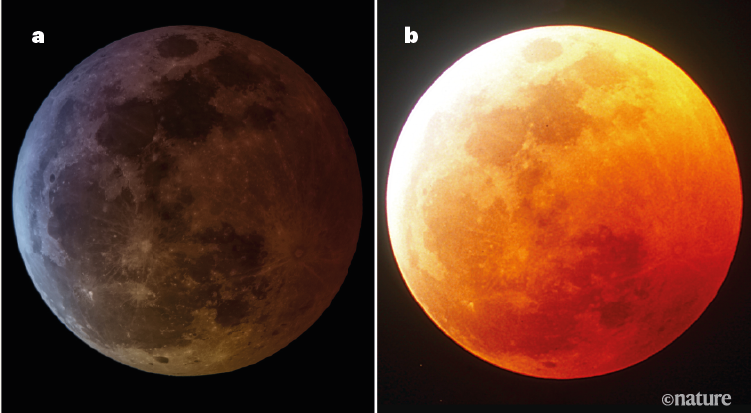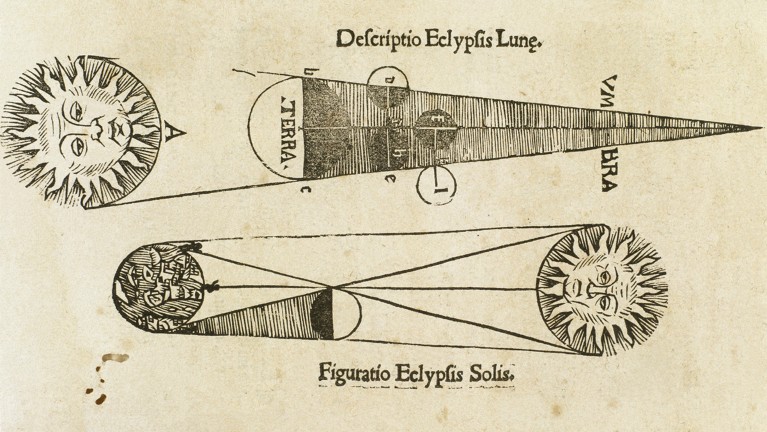THE PAPER IN BRIEF
• Volcanic eruptions inject large volumes of sulfur dioxide into the atmosphere that are converted into aerosols in the stratosphere1.
• These aerosols produce volcanic dust that can reduce incoming solar radiation, altering Earth’s surface temperatures, precipitation and atmospheric circulation2.
• Identifying past volcanic eruptions can therefore help to clarify the timing and nature of climate events, but current methods produce conflicting results.
• In a paper in Nature, Guillet et al.3 report an approach that interprets medieval accounts of lunar eclipses to date volcanic eruptions that could have shaped a key climatic transition.
ANDREA SEIM & EDUARDO ZORITA: A fresh take on an old challenge
Climate scientists usually identify past volcanic eruptions by measuring the acidity and amount of volcanic ash in cores drilled from polar ice, or by inferring abrupt temperature changes in tree-ring records. However, these sources sometimes disagree, because the location, intensity and timing of eruptions can produce varying results, as can circulation of the atmosphere. Guillet and colleagues’ approach offers an independent — and perhaps even more direct — source of information about the timing of volcanic eruptions, which could resolve some of these disagreements.
During a total lunar eclipse, the Moon is fully in Earth’s shadow. A dark Moon indicates that volcanic aerosols are highly abundant in the stratosphere, whereas a reddish Moon suggests that they are scarce (Fig. 1). Guillet et al. examined historical accounts of lunar eclipses from the High Medieval Period (1100–1300), and estimated the abundance of volcanic aerosols from the descriptions of the colour and luminosity of the Moon. They used this information to refine the timing of a cluster of volcanic eruptions that occurred during this period, and which had previously been identified using ice-core measurements4. The authors found that seven of these eruptions generated aerosols that could have had a role in the transition from the Medieval Climate Anomaly (around 850–1250) to the Little Ice Age (around 1300–1850).

Figure 1 | The colours of total lunar eclipses. a, A dark Moon during a lunar eclipse indicates that Earth’s stratosphere contains a large amount of volcanic aerosols. This photograph was taken in January 2019, roughly one month after the eruption of Anak Krakatau in Indonesia. b, A bright reddish Moon suggests that volcanic aerosols are scarce, as shown in this photograph from January 2001. Guillet et al.3 used historical accounts of the colours of lunar eclipses to infer the climatic impact of volcanic eruptions in the High Medieval Period (1100–1300).Credit: Giuseppe Donatiello (CC0 1.0)
The strength of Guillet and co-workers’ study lies in the precision with which the authors estimated the timing of volcanic eruptions — pinpointing the year, and even in some cases the month, of the event. The authors compared their findings with modern global aerosol measurements, climate model simulations and satellite observations to link five dark and two reddish lunar eclipses to major eruptions during the High Medieval Period. They found that the dark lunar eclipses were observable for 3–20 months after an eruption.
Read the paper: Lunar eclipses illuminate timing and climate impact of medieval volcanism
They then examined tree-ring records sensitive to summer temperatures in the Northern Hemisphere, in which an unusually cold summer is indicated by reduced wood formation. By combining these records with climate simulations, the authors further refined the timing of five eruptions and showed that they had a pronounced impact on the climate. The remaining eruptions seem to have had less effect.
Guillet and colleagues’ findings will improve our understanding of how much volcanic eruptions contributed to the onset of the Little Ice Age compared with other factors, including a period of low solar activity between 1280 and 1340. Climate models suggest that a volcano-induced cooling in surface temperatures can lower ocean temperatures and expand sea ice5. This can, in turn, stretch the effects of a volcano over several decades, and could even plunge the climate system into a different state — a prospect that has relevance for modern warming as a result of anthropogenic greenhouse-gas emissions. Although the climatic changes caused by volcanic and anthropogenic emissions differ, understanding how the climate system reacts to different types of perturbation will also help to refine the next generation of climate models6. And getting the timing right is crucial, which is why innovative approaches such as that of Guillet and colleagues are so valuable.
ANNE LAWRENCE-MATHERS: Making sense of historical records
Guillet and colleagues’ findings are underpinned by hundreds of records chronicling 187 lunar eclipses between 1100 and 1300. Their approach to linking these events to the climatic impact of volcanic eruptions hinges on descriptions of the colour of the Moon. Such information is scarce in these records, except in Christian sources, in which the colour and brightness of the Moon is documented in 36 of the eclipses studied. But the authors faced difficulties in dating these eclipses because the sources are not always consistent — a challenge related to medieval church bureaucracy.
The aberrant global synchrony of present-day warming
In the medieval Christian world, lunar phases and eclipses were used for setting the dates of religious festivals and timing medical treatments — or for determining whether a darkened Moon was a sign from God. New astronomical tools and theories were therefore valued highly. Calculating the lunar calendar accurately was important to Christians because the Moon touched on so many of their activities.
Such studies certainly became more accurate when Latin translations of Islamic astronomical texts and planetary tables were made available in Europe from around 11507. However, these texts used an entirely different calendar and referenced dates that were meaningful only for their original compilers. They also described astronomical observations that were made far from northern Europe. Early translations were literal and offered little help to users unfamiliar with the Islamic calendar.
The resulting struggles are clear in the writings of a monk known as John, who chronicled sunspots and a solar eclipse from his post at Worcester Cathedral in England at the start of the High Medieval Period. John made detailed records of these astronomical phenomena, but still failed to understand the Islamic methods for calculating lunar eclipses8,9. Nevertheless, the planetary tables were valued, and — once more-sophisticated translations and recalculations had been produced — they formed the basis of textbooks on astronomy. One such book was written by Johannes de Sacrobosco in around 1220, and immediately became widely used (Fig. 2). How, then, could there be continuing doubts about the timing and identification of lunar eclipses?

Figure 2 | A diagram of solar and lunar eclipses, from a printed edition of Johannes de Sacrobosco’s astronomical text (around 1220).Credit: Prima Archivo/Alamy
Central to the answer is the fact that the solar year did not align exactly with a year in the Julian calendar. Sacrobosco argued that the accumulated error had reached some 11 days by around 1230 and that Easter was therefore being celebrated on the wrong day10. Church leaders were aware of the problem, but feared there would be serious resistance to changing the calendar11. The timing of phases of the Moon was therefore out of step with the calendars of major religious institutions.
Church chroniclers faced a dilemma. Some saw a darkening of the Moon as a clear sign of an eclipse, whereas others interpreted it differently. The problem was exacerbated by the fact that a given eclipse might be more clearly visible in some parts of Europe than others, and that information took time to be transmitted between regions. For these reasons, the lack of agreement between medieval chroniclers on the timing of total eclipses of the Moon should not be seen as the result of religious censorship or ignorance — they were simply days out of sync. In this context, Guillet and co-workers’ accomplishment in overcoming this problem to link historical sources to climate events is all the more impressive.

 Read the paper: Lunar eclipses illuminate timing and climate impact of medieval volcanism
Read the paper: Lunar eclipses illuminate timing and climate impact of medieval volcanism
 The aberrant global synchrony of present-day warming
The aberrant global synchrony of present-day warming





